
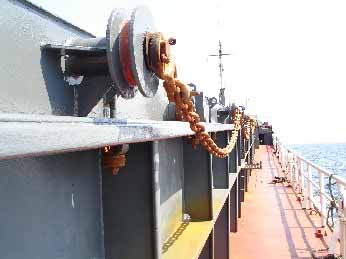


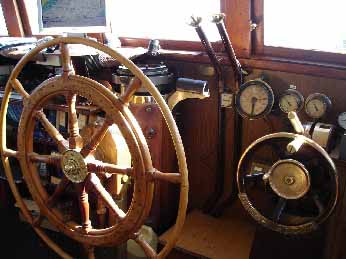

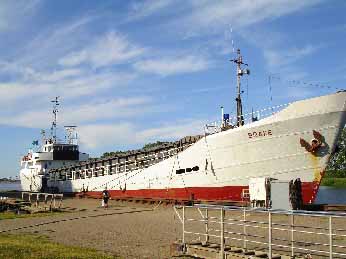
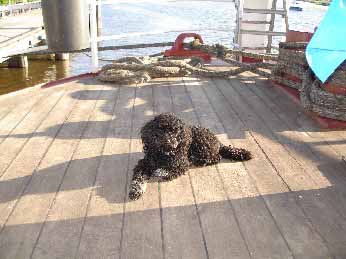

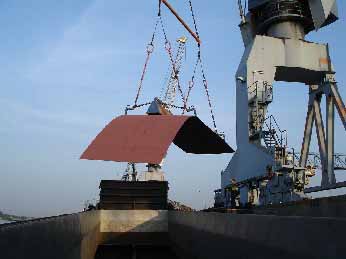




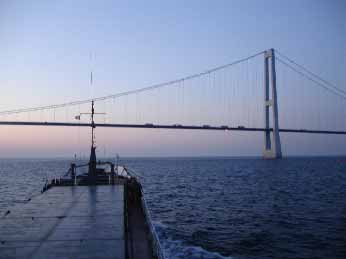
M/S Brake
 |
 |
|
 |
||
 |
 |
 |
 |
 |
 |
 |
 |
 |
 |
 |
 |
The M/S "Brake" is a coaster. She operates mainly in the Baltic and North Sea but eventually makes voyages as far as to the Mediterranian or to Iceland. She is only 59 m long and has a cargo capacity of 730 metric tons. Her cargo is everything not containerized - although if necessary she could also load 12 standard containers. Most of her cargoes are bulk cargoes such as grain or fertilizers or animal food. Another standard cargo is steel plates. She sometimes takes project cargo such as the engines seen in the photo above or any kind of general cargo, such as boxes, bags, packs, coils of everything.
The Brake is an old ship. In June 2007 the crew celebrated the 50th anniversary of her commisioning. Since 16 years she is owned and operated by Olaf Ohlrogge who himself sails her as master. Almost as long on board is Stanislav, his Polish motor man who cares for the engine and actually also for everything else. Furtheron the crew consists of a mate and one or two deck ratings of whom one is also the cook.
I first joined the ship in Summer 2006 as a part of the practical education compulsary for my mate's ticket. Meanwhile I have returned two more times since I really like the old tramp still going strong and the life on board which is so much more like the seafaring was in the old days than the life on the modern container ships is. A lot of work you find everywhere, but on a coaster you still get the chance to see a bit of the ports you visit as you call in small ports where cargo works stop over the nights and the weekends and so there is often the possibility to go ashore for a pint or a bit of sight seeing.
This ship is also a perfect place to learn how to really drive a ship. On big and fast modern ships with their tight schedules and small crews the cadet who comes there for practical training very often can call himself happy if he is allowed to watch the crew operating the ship or if a training officer explains to him what the master and chief mate are actually doing. Not so on "Brake". Here I am involved in everything and may put my theoretical knowledge on a test. Together with the mate I may plan, execute and supervise the cargo works, I may take over a watch, plan a passage. Together with the master I can try to bring the ship alongside the quay or to manoeuvre her into a lock. I can take over responsibility in leading and organizing the works on deck and teaching our new filippino deck hands the basics of maintenance and seamanship.
Unfortunately these old coasters are a rare sight in our times. Modern port management and international regulations make life difficult for them in just the same ways as the tall ships have to fight to stay afloat. Traffic regulation is pesting the European waters with compulsary highways and no-go-zones which are a good thing for the big and fast vessels. But when you are small and slow they can be dangerous for you with all the fast runners overtaking you and sometimes not realizing that - especially in bad weather - you are severely restricted in your abilities to change course without risking damage of ship and cargo. The ISPS and ISM codes cause the masters a mountain of extra paperwork, fence the ships and their crews in inside the ports and makes the seafarers feel like prisoners. The STCW crewing regulations force the operators to man even the smallest ships with crew that is qualified to run a super tanker or 10 000 teu container vessel while the same regulations say that the officer who then works only on the small ships will loose his licences after 5 years as he did not work on big ships. So it becomes more and more difficult to find qualified and good personnel for the old veterans and even though it is tempting for me to work on a coaster after completing my education I will have to think twice if it is wise to do so.
this page was updated 10/07